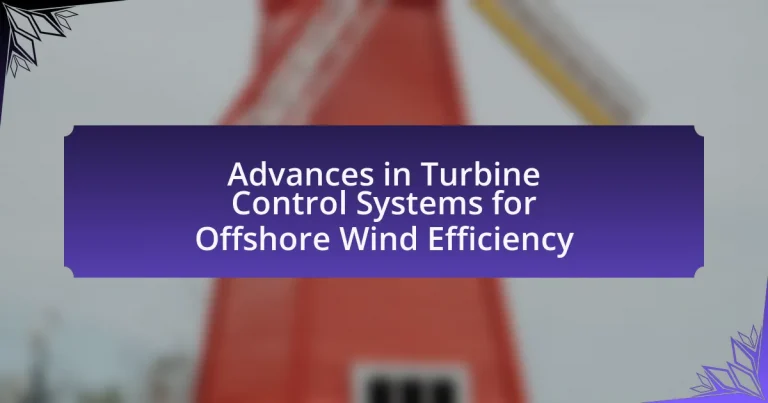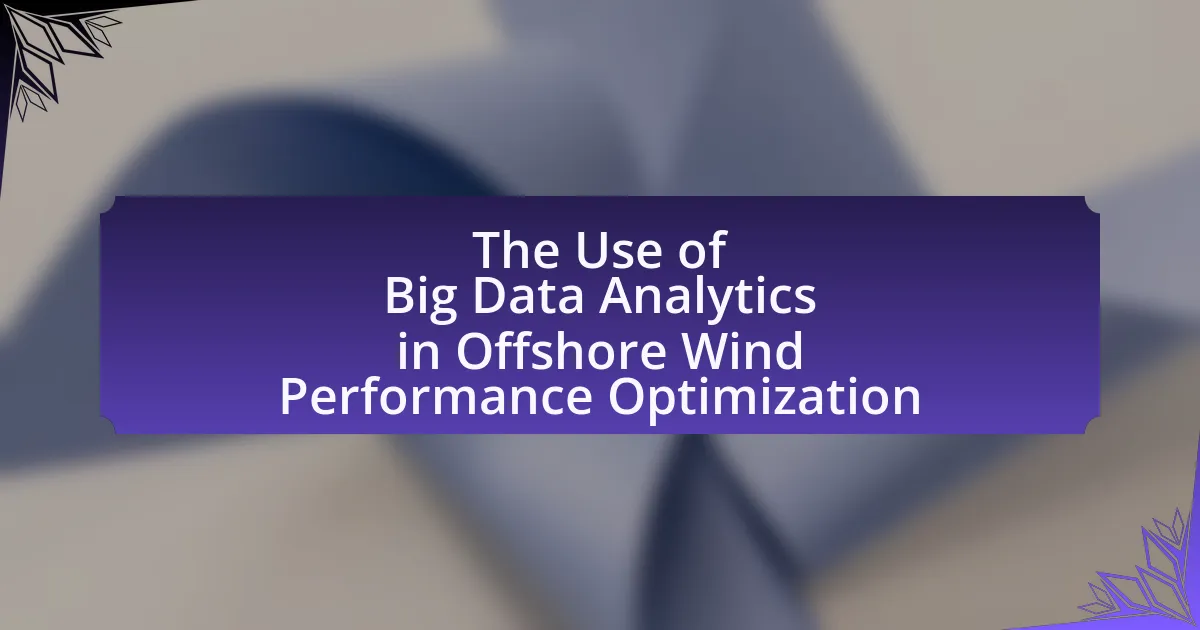The article focuses on recent advances in turbine control systems aimed at enhancing offshore wind efficiency. Key developments include the implementation of advanced predictive algorithms, machine learning techniques, and digital twins, which collectively optimize turbine performance and energy output. The article discusses how these technologies improve operational reliability, reduce maintenance costs, and contribute to sustainability by minimizing greenhouse gas emissions. Additionally, it addresses the challenges of integrating these advanced systems, the impact of regulatory frameworks, and best practices for maintaining turbine control systems to ensure longevity and efficiency.
What are the recent advances in turbine control systems for offshore wind efficiency?
Recent advances in turbine control systems for offshore wind efficiency include the implementation of advanced predictive algorithms and machine learning techniques. These technologies enhance real-time decision-making by analyzing vast amounts of operational data to optimize turbine performance and energy output. For instance, the integration of model predictive control (MPC) has been shown to improve energy capture by up to 10% by anticipating wind conditions and adjusting turbine settings accordingly. Additionally, the use of digital twins allows for continuous monitoring and simulation of turbine behavior, enabling proactive maintenance and reducing downtime. These innovations collectively contribute to increased efficiency and reliability in offshore wind energy production.
How have technological innovations impacted turbine control systems?
Technological innovations have significantly enhanced turbine control systems by improving efficiency, reliability, and performance. Advanced algorithms, such as model predictive control and machine learning, enable real-time optimization of turbine operations, leading to increased energy output and reduced wear on components. For instance, the integration of IoT sensors allows for continuous monitoring of turbine conditions, facilitating predictive maintenance and minimizing downtime. Additionally, innovations in data analytics provide insights into operational patterns, enabling better decision-making and adaptive control strategies. These advancements collectively contribute to the overall effectiveness and sustainability of offshore wind energy systems.
What specific technologies are driving these advancements?
The specific technologies driving advancements in turbine control systems for offshore wind efficiency include advanced sensor technologies, machine learning algorithms, and real-time data analytics. Advanced sensor technologies enable precise monitoring of environmental conditions and turbine performance, which is crucial for optimizing energy output. Machine learning algorithms analyze vast amounts of operational data to predict maintenance needs and enhance control strategies, thereby improving efficiency. Real-time data analytics facilitate immediate adjustments to turbine operations based on changing wind conditions, maximizing energy capture. These technologies collectively contribute to increased reliability and performance in offshore wind energy generation.
How do these technologies improve overall efficiency?
Advances in turbine control systems for offshore wind improve overall efficiency by optimizing energy production and reducing operational downtime. These technologies utilize real-time data analytics and predictive maintenance to enhance turbine performance, ensuring that turbines operate at their maximum capacity under varying wind conditions. For instance, studies have shown that advanced control algorithms can increase energy capture by up to 10% compared to traditional systems. Additionally, by predicting equipment failures before they occur, these systems minimize maintenance costs and extend the lifespan of the turbines, further contributing to efficiency gains.
What role do data analytics play in turbine control systems?
Data analytics play a crucial role in turbine control systems by enhancing operational efficiency and predictive maintenance. By analyzing real-time data from turbine sensors, operators can optimize performance, reduce downtime, and improve energy output. For instance, data analytics can identify patterns in wind conditions and turbine behavior, allowing for adjustments that maximize energy capture. Additionally, predictive analytics can forecast potential failures by monitoring wear and tear, leading to timely maintenance interventions. This proactive approach not only extends the lifespan of turbines but also significantly lowers operational costs, as evidenced by studies showing that predictive maintenance can reduce maintenance costs by up to 30%.
How is data collected and analyzed in offshore wind farms?
Data in offshore wind farms is collected through a combination of sensors, monitoring systems, and data acquisition technologies. These systems gather information on wind speed, direction, temperature, turbine performance, and environmental conditions. The collected data is then analyzed using advanced algorithms and software tools to optimize turbine operations, predict maintenance needs, and enhance overall efficiency. For instance, the integration of SCADA (Supervisory Control and Data Acquisition) systems allows for real-time monitoring and analysis, enabling operators to make informed decisions based on accurate and timely data.
What insights can data analytics provide for optimizing turbine performance?
Data analytics can provide insights for optimizing turbine performance by identifying patterns in operational data, predicting maintenance needs, and enhancing energy output. By analyzing historical performance data, operators can detect inefficiencies and implement corrective measures, leading to improved reliability and reduced downtime. For instance, predictive analytics can forecast potential failures based on trends in vibration, temperature, and other operational metrics, allowing for timely maintenance interventions. Studies have shown that utilizing data analytics can increase turbine efficiency by up to 10%, significantly boosting overall energy production in offshore wind farms.
Why is turbine control system efficiency critical for offshore wind energy?
Turbine control system efficiency is critical for offshore wind energy because it directly impacts energy production and operational reliability. Efficient control systems optimize the performance of wind turbines by adjusting their settings in real-time to maximize energy capture from varying wind conditions. For instance, studies show that advanced control algorithms can increase energy output by up to 10% compared to traditional systems, significantly enhancing the overall energy yield of offshore wind farms. Additionally, efficient control systems reduce wear and tear on turbine components, leading to lower maintenance costs and extended operational lifespans, which is essential for the economic viability of offshore wind projects.
What are the environmental benefits of improved turbine efficiency?
Improved turbine efficiency significantly reduces greenhouse gas emissions. By optimizing energy production, efficient turbines require less fuel to generate the same amount of electricity, leading to lower carbon dioxide emissions. For instance, a study by the National Renewable Energy Laboratory found that increasing wind turbine efficiency can decrease the reliance on fossil fuels, which are major contributors to climate change. Additionally, enhanced turbine performance minimizes land use and habitat disruption, as fewer turbines are needed to produce the same energy output, thereby preserving local ecosystems.
How does increased efficiency contribute to reduced carbon emissions?
Increased efficiency in turbine control systems for offshore wind contributes to reduced carbon emissions by optimizing energy production and minimizing waste. Efficient turbines generate more electricity from the same wind resource, which reduces reliance on fossil fuel-based energy sources. For instance, a study by the National Renewable Energy Laboratory found that enhancing turbine efficiency can lead to a 20% increase in energy output, significantly decreasing the carbon footprint associated with energy generation. By maximizing the conversion of wind energy into electricity, these advanced systems help lower overall greenhouse gas emissions, supporting climate change mitigation efforts.
What impact does efficiency have on energy production and sustainability?
Efficiency significantly enhances energy production and sustainability by maximizing output while minimizing resource consumption. In the context of offshore wind energy, advanced turbine control systems optimize performance, leading to increased energy generation per unit of wind. For instance, studies indicate that improved turbine efficiency can raise energy output by up to 20%, which directly contributes to reducing reliance on fossil fuels and lowering greenhouse gas emissions. This efficiency not only supports sustainable energy goals but also promotes economic viability by decreasing operational costs and increasing the return on investment for renewable energy projects.
How do turbine control systems enhance operational reliability?
Turbine control systems enhance operational reliability by continuously monitoring and adjusting turbine performance to optimize energy output and minimize mechanical stress. These systems utilize advanced algorithms and real-time data from sensors to detect anomalies, enabling proactive maintenance and reducing the risk of failures. For instance, studies have shown that predictive maintenance strategies, facilitated by turbine control systems, can decrease downtime by up to 30%, thereby improving overall reliability and efficiency in offshore wind operations.
What are the common failure modes in turbine operations?
Common failure modes in turbine operations include mechanical failures, electrical failures, and control system failures. Mechanical failures often involve issues such as blade damage, gearbox malfunctions, and bearing wear, which can lead to reduced efficiency or complete shutdown. Electrical failures may arise from issues like generator faults, wiring problems, or inverter failures, impacting power output and system reliability. Control system failures can occur due to software bugs, sensor malfunctions, or communication errors, which can disrupt the turbine’s operational parameters and efficiency. These failure modes are critical to monitor, as they can significantly affect the overall performance and reliability of turbine operations in offshore wind energy systems.
How can advanced control systems mitigate these risks?
Advanced control systems can mitigate risks in offshore wind efficiency by optimizing turbine performance and enhancing grid stability. These systems utilize real-time data analytics and predictive algorithms to adjust turbine operations based on environmental conditions, thereby reducing mechanical stress and improving energy output. For instance, studies have shown that implementing model predictive control can lead to a 10-15% increase in energy capture while minimizing wear and tear on turbine components. This proactive management not only enhances operational efficiency but also lowers maintenance costs and extends the lifespan of the turbines, ultimately contributing to a more reliable and sustainable energy source.
What are the challenges faced in implementing advanced turbine control systems?
The challenges faced in implementing advanced turbine control systems include technical complexity, integration with existing infrastructure, and the need for specialized expertise. Technical complexity arises from the sophisticated algorithms and real-time data processing required for optimal performance, which can lead to difficulties in system design and maintenance. Integration with existing infrastructure poses challenges as new systems must be compatible with older technologies, often requiring significant modifications. Additionally, the need for specialized expertise in both software and hardware to manage these advanced systems can limit the availability of qualified personnel, hindering effective implementation.
What technical barriers exist in the deployment of these systems?
Technical barriers in the deployment of turbine control systems for offshore wind efficiency include challenges related to integration with existing infrastructure, data transmission reliability, and environmental conditions. Integration issues arise from the need to ensure compatibility between new control systems and legacy equipment, which can lead to increased costs and complexity. Data transmission reliability is critical, as offshore environments often experience signal disruptions due to distance and weather, impacting real-time monitoring and control. Additionally, environmental conditions such as high winds, saltwater corrosion, and extreme temperatures can affect the durability and performance of control systems, necessitating robust engineering solutions to mitigate these risks.
How do weather conditions affect turbine control system performance?
Weather conditions significantly impact turbine control system performance by influencing operational efficiency and safety. For instance, high wind speeds can lead to the activation of protective measures within the control system, causing turbines to shut down to prevent damage. Conversely, low wind conditions may result in reduced energy generation as the control system optimizes turbine angles for maximum efficiency. Additionally, adverse weather, such as heavy rain or icing, can affect sensor accuracy and responsiveness, leading to potential performance degradation. Studies have shown that turbine performance can decrease by up to 20% during extreme weather events, highlighting the critical need for adaptive control strategies that account for varying weather conditions.
What are the costs associated with upgrading existing systems?
The costs associated with upgrading existing systems in turbine control for offshore wind efficiency include hardware expenses, software licensing fees, installation costs, and potential downtime during the upgrade process. Hardware expenses can range from thousands to millions of dollars depending on the complexity of the system and the scale of the wind farm. Software licensing fees may also vary significantly, often requiring annual subscriptions or one-time payments that can add up to substantial amounts. Installation costs typically involve labor and logistics, which can further increase the overall expenditure. Additionally, downtime during the upgrade can lead to lost revenue, as turbines may not be operational while the upgrades are being implemented. According to a report by the International Renewable Energy Agency, the total costs for upgrading turbine control systems can represent a significant portion of the overall operational budget, emphasizing the need for careful financial planning.
How can regulatory frameworks influence turbine control system advancements?
Regulatory frameworks can significantly influence turbine control system advancements by establishing standards that drive innovation and compliance in technology development. These frameworks often mandate specific performance metrics, safety protocols, and environmental considerations, compelling manufacturers to enhance their control systems to meet these requirements. For instance, regulations set by organizations such as the International Electrotechnical Commission (IEC) outline performance criteria for wind turbine systems, which encourages the adoption of advanced control algorithms and real-time monitoring technologies to optimize efficiency and reliability. Consequently, adherence to these regulations not only fosters technological advancements but also ensures that turbine systems operate within safe and environmentally responsible parameters.
What regulations are currently in place for offshore wind energy?
Currently, regulations for offshore wind energy primarily include the National Environmental Policy Act (NEPA), which mandates environmental assessments for projects, and the Outer Continental Shelf Lands Act (OCSLA), which governs leasing and development on the continental shelf. Additionally, the Bureau of Ocean Energy Management (BOEM) oversees permitting processes, ensuring compliance with federal laws and environmental standards. These regulations are designed to balance energy development with environmental protection, as evidenced by the requirement for comprehensive environmental reviews and stakeholder consultations before project approval.
How do these regulations impact innovation in turbine control systems?
Regulations significantly influence innovation in turbine control systems by establishing safety, efficiency, and environmental standards that drive technological advancements. These regulations often require manufacturers to develop more sophisticated control systems that can optimize performance while adhering to stringent operational guidelines. For instance, the European Union’s Renewable Energy Directive mandates specific efficiency targets for offshore wind farms, prompting companies to innovate in areas such as predictive maintenance and real-time data analytics to enhance turbine performance and reliability. This regulatory framework not only fosters competition among developers but also accelerates the adoption of cutting-edge technologies, ultimately leading to improved energy output and reduced operational costs in offshore wind energy production.
What best practices can be adopted for optimizing turbine control systems?
To optimize turbine control systems, implementing advanced predictive maintenance techniques is essential. These techniques utilize data analytics and machine learning algorithms to forecast potential failures, thereby reducing downtime and maintenance costs. For instance, a study by the National Renewable Energy Laboratory found that predictive maintenance can decrease maintenance costs by up to 30% and increase turbine availability by 10%. Additionally, integrating real-time monitoring systems enhances operational efficiency by allowing for immediate adjustments based on environmental conditions and turbine performance. This approach not only maximizes energy output but also extends the lifespan of the turbine components.
How can operators ensure the longevity of turbine control systems?
Operators can ensure the longevity of turbine control systems by implementing regular maintenance schedules and utilizing advanced monitoring technologies. Regular maintenance, including inspections and component replacements, helps identify wear and tear before it leads to system failures. Advanced monitoring technologies, such as condition-based monitoring systems, provide real-time data on the performance and health of control systems, allowing for proactive interventions. Studies have shown that turbines with effective maintenance programs can achieve up to 20% longer operational lifespans compared to those without.
What maintenance strategies are most effective for these systems?
Predictive maintenance strategies are the most effective for turbine control systems in offshore wind efficiency. These strategies utilize data analytics and machine learning algorithms to predict potential failures before they occur, allowing for timely interventions. For instance, a study by Zhang et al. (2020) demonstrated that predictive maintenance reduced downtime by 30% and maintenance costs by 25% in offshore wind farms. By continuously monitoring system performance and environmental conditions, operators can optimize maintenance schedules, thereby enhancing overall turbine efficiency and reliability.




